us.edmodo.co.id – Today’s corporate rivalry is nothing like it was 15 or 20 years ago. Companies employed door-to-door sales approaches as one of the most effective marketing strategies in the past; however, these techniques are no longer viable. Digital marketing has been successful in replacing it.
A digital marketing strategy is a broad-reaching marketing approach. To master it, you must be willing to study numerous mediums at the same time and put your knowledge into practice.
In the conversation below, you may learn more about what digital marketing is, its benefits, advantages, and examples.
What is Digital Marketing?
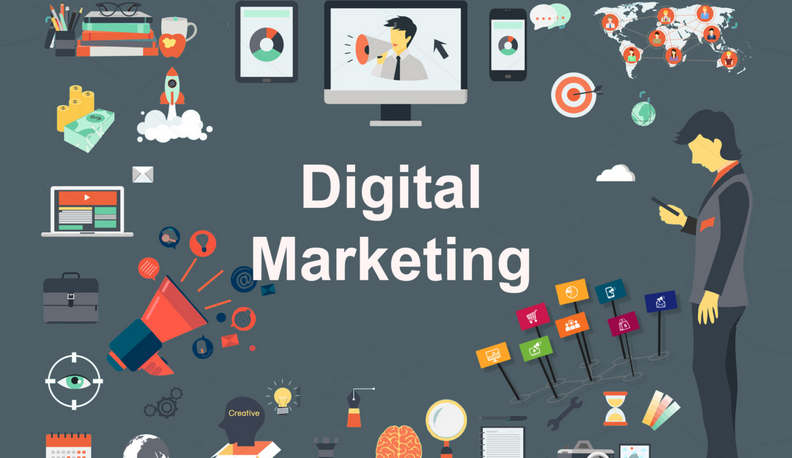
One of the current trends that you and your company team must learn if you don’t want to fall behind the competition is digital marketing.
Every expert defines the concept of digital marketing differently. However, OCBC NISP will refer to the world’s most notabl specialists in this content.
According to Marketo, digital marketing is a high-level strategy of promotion/advertising distributed through search engines (Google, Bing, Yahoo, etc.), websites, social media, email, and apps.
According to the Smart Insights version, digital marketing is the ability to reach customers using devices, platforms, media, data, and digital technology. Meanwhile, Hubspot defines as “any marketing initiatives that use electronic devices and the internet.”
We may infer that is a strategy for acquiring customers via the use of numerous digital technologies (tools) in physical and non-physical forms.
Advantages of Digital Marketing Compared to Ordinary Marketing Strategies
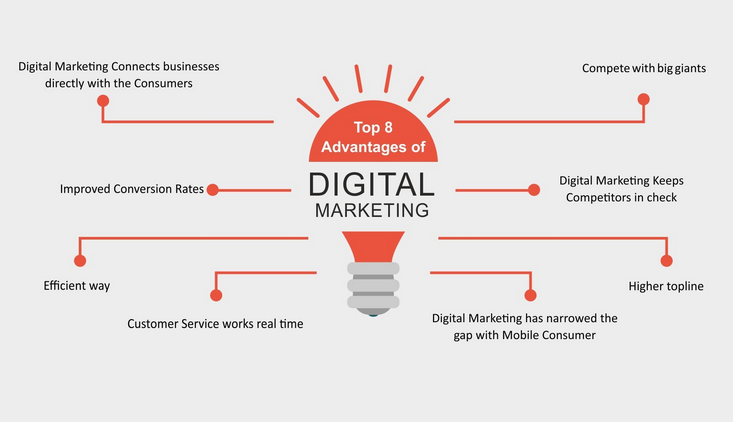
After learning what digital marketing is from the professionals, we will review some of the benefits of digital marketing over traditional marketing tactics, such as:
More Cost-Effective
The first advantage of digital marketing is that it is less expensive than traditional market methods. You will most likely require a large sum of money at the start of the branding procedure. However, once your brand and fan base are established, your expenditures will be reduced.
Don’t Need a Lot of Sales Human Resources
HR wages are a major source of traditional marketing spending. This, however, will not be an issue if you employ a digital marketing approach.
It is no longer necessary to pay a large number of individuals to market things in dwellings or on the streets. You may already sell things by just sharing product promos on social media.
The Marketing Team Doesn’t Need to Go into the Field
On this point, the benefits of are still tied to the preceding point. Digital marketing is a method that eliminates the need for your team to leave the house/office in order to locate consumers. Your marketing staff may already promote by just sitting in front of your laptop/HP and using the internet.
Easier Product Branding Process The
The fourth advantage of digital marketing is that it makes branding more easier and faster. One of the most significant disadvantages of traditional marketing is its extremely restricted choice of promotions.
If you want to brand to more customers, the traditional technique requires you to spend more money. When you use a digital marketing approach, things change. You may reach people from all around Indonesia and even abroad with only one piece of content or advertisement.
Potential for Drastic Growth
The fifth benefit of digital marketing is the possibility for dramatic expansion of your firm, particularly in terms of revenue.
There are several examples of organizations expanding in a matter of months as a result of applying methods. It does not take ten or twenty years to become an industry leader in digital marketing.
Benefits of Digital Marketing for Companies
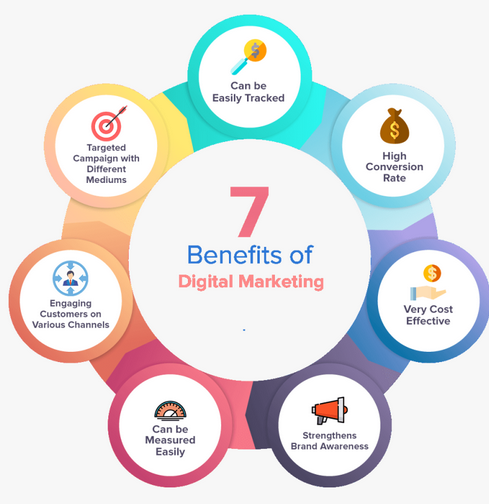
After reviewing the advantages of digital marketing over traditional market, we will now address the advantages for businesses, which include:
Removing Territory and Time Restrictions When Marketing Products
The first advantage of digital is the absence of marketing sector barriers. You have the freedom to market your items anywhere and whenever you choose, whether on a local, national, or worldwide basis.
Faster and Targeted Product Sales System The
The second advantage of digital marketing is that the product sales mechanism is speedier and more responsive to consumer desire.
When you create an internet ad, you may provide the criteria for those who would be good consumers for you. Your adverts will be more effective as a result, and transactions will be easier.
Easier to Build Relationships with Consumers
You don’t have to meet directly with customers to offer them with services while using internet marketing. Simply by interacting with them on social media, you may develop a deep relationship with them.
Opportunity to Personalize Products According to Consumer Characteristics
The second advantage of digital marketing is the enormous opportunity for product customization. You may do research on the character profiles of individuals who are interested in your product/content through internet promotion channels. Following that, you can develop product advancements based on the prior study findings.
Get a Big Profit in a Short Time
The possibility to earn several times the profit in a shorter period of time is the final benefit of digital marketing. Although it still takes a lot of work, is the most effective and efficient approach to reach out to more prospective customers and advertise items without having to spend a lot of money.
Types of Digital Marketing
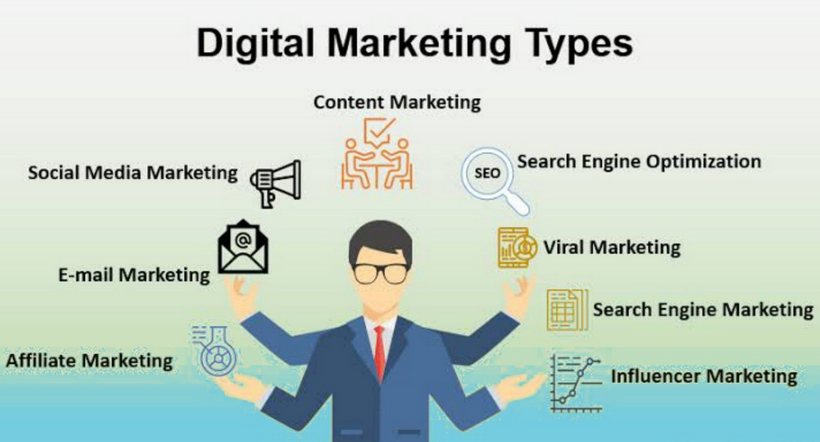
You may use a variety of digital marketing techniques, including:
Search Engine Marketing (SEM)
Search engine marketing or SEM is a type of digital marketing that focuses on product promotion through search engines such as Google, Bing, Yahoo, and so on.
This one digital marketing plan entails the establishment of a website, the building of landing pages (special promotional websites), the installation of Ads, and so on.
Social Media Marketing
Social media marketing is the next sort of digital marketing. This sort of digital marketing may be implemented by employing numerous social media platforms such as Youtube, Tiktok, Instagram, Twitter, Facebook, and other media based on your target customers.
Email Marketing
Email marketing, or marketing by electronic mail, is the third sort of digital marketing (e-mail). This digital marketing approach is best suited for organizations that operate on a business-to-business (B2B) paradigm.
Digital Advertising
As the name implies, digital advertising or ads is a sort of digital marketing in which adverts are placed on numerous internet platforms ranging from websites to social media. Google Ads, Facebook/Instagram Ads, YouTube Ads, and Tiktok Ads are some of the most prominent digital advertising networks.
Content Marketing
Material marketing is a sort of digital marketing that includes content in the form of writing, audio, photos, or video. Content is typically done in conjunction with social media, email, or digital adverts.
Customer Service Automation
Customer service automation is the sixth category of digital marketing. Because of the availability of automation, businesses may gather information on potential clients from the moment they engage with the product/company for the first time.
Following that, the information may be instantly transferred to the customer service or sales team for the closing procedure (the occurrence of sales).
Affiliate/Dropshipping
The final sort of digital marketing is affiliate marketing or dropshipping. When you use this digital marketing method, you may earn from online intermediaries (dropshippers) while also assisting them in making money.
Common Mistakes in Digital Marketing
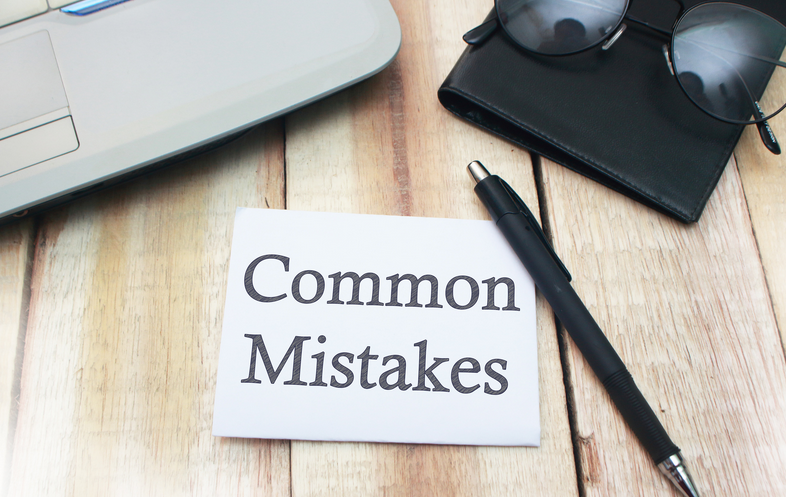
The numerous benefits provided by the notion of digital marketing are definitely appealing.
However, it is crucial to remember that the following faults must be avoided when adopting a idea so that your firm can function according to the marketing strategy.
1. Strategies that are not right on target
Strategy and planning are the initial steps in determining a company’s path. Trends are so easily changing, especially in the digital world, that customers’ demands and preferences are becoming increasingly diversified every day.
In order to gain a lot of consumer publicity, some marketers are often sloppy in picking their target market.
This will complicate digital marketing, particularly when studying the audience that visits your goods.
Before releasing a product or service to the general public, you must first identify its purpose and marketing strategy.
Make certain that the marketing strategy you develop is specific, on target, and easily accessible to the target market.
2. Understanding Prospective Consumers The
The venture must be able to meet the demands of the consumers. However, many businesspeople continue to overlook this, resulting in goods that are out of step with market demand.
That is why, before designing a marketing plan, you must first determine the degree of market demand.
Business values are vital, but goods must also consider the audience, what their requirements are, and what the tastes and trends of potential buyers are.
Understanding potential clients does not need changing your product, but rather tweaking the packaging, advertising material, and Key Opinion Leader selection.
Using Google Trends, you may look for emerging product trends in your neighborhood. Simply type the product name into the search area, and Google Trends will provide a graph of the product’s demand.
3. Ignoring Digital Marketing
Digital marketing focuses not only on more convenient promotional elements, but also on measurable results.
Whereas seeing marketing performance through numerical analysis is one of the cornerstones of a businessman employing.
How many people are aware of our brand, visit our website, or click on search engine ads?.
4. Ignoring Story-telling and Copywriting
Content is directly tied to digital marketing. Writing is the most critical aspect of content development. Whether it is design or video content, the job of copywriting is critical in conveying the message to potential customers.
The writing must also be able to make an effect on the audience and educate them so that the product offered may be readily achieved.
Digital Marketing Strategies & Examples
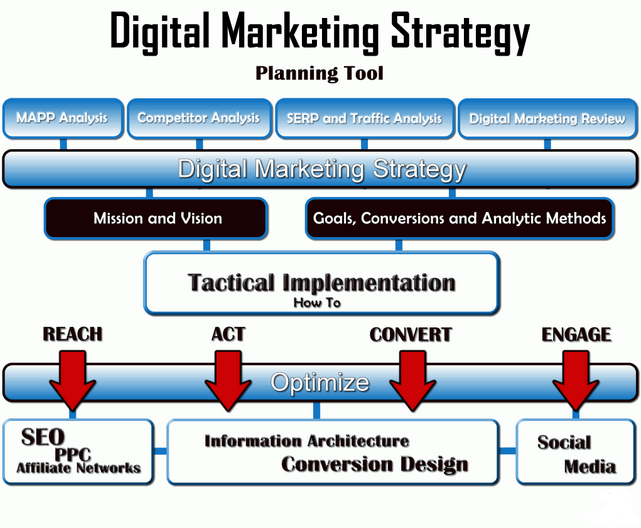
You now understand what digital marketing is, its benefits, and its many varieties. Following that, we will go through several digital marketing techniques and instances of their application.
Search Engine Optimization (SEO)
The first aspect of a digital marketing plan is SEO, which is an attempt to increase website traffic naturally without the use of advertisements. Article development, site speed optimization, and putting site links on other websites are all examples of digital marketing in the realm of SEO.
Social Media Activation (Instagram, Youtube, Tiktok, etc.)
Social media activation is the second digital marketing tactic. Social media digital marketing examples include frequently posting material to social media, engaging with followers, doing endorsements, and much more.
Knowledge Marketing
Expertise marketing is a digital marketing technique that involves supplying potential customers with relevant information or new knowledge. Email marketing and the publishing of ebooks are two examples of digital marketing through information distribution (digital books).
Data Analysis and Search
Data tracking and analysis are critical components of developing a digital marketing plan. Every choice made in the digital marketing process, from social media data to online advertising campaigns, must be founded on facts.
Hard-selling, Soft-selling, and Hypno-selling
Digital marketing is one of the most popular sales strategies. Hard-selling, soft-selling, and hypno-selling are the three most popular sales words you may encounter while adopting a digital marketing plan.
Google and Social Media Ads
Google and Social Media Ads are the sixth digital marketing strategy tactic. When developing Ads, you must ensure that the ad content conveys the correct message to the intended audience. As a result, Ads can create the intended sales.
Leads Generation
Lead generation is the seventh and last point of a digital marketing plan. Leads are described in the marketing industry as any type of contact that may be utilized to reach customers, such as phone numbers, social media accounts, or emails. Seminars or free books are examples of content lead magnets.
This is a comprehensive OCBC NISP overview of what digital marketing is, its advantages, benefits, kinds, and digital marketing techniques and examples! Digital marketing is one of the most important talents for every firm nowadays, so don’t put it off!
Don’t forget to look here too :